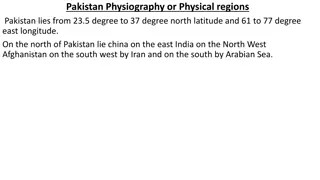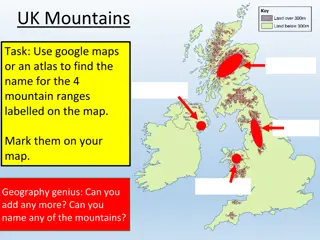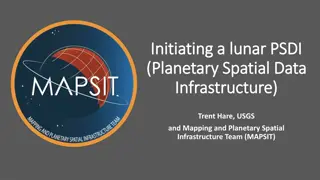2024 Lunar New Year Preprations
The celebration for Chinese New Year 2024 started on February 10. New Year is almost here, also called the Lunar New Year. It brings a happy celebration full of tradition and culture.
177 views • 22 slides
NASA Integrated Lunar Science Strategy in the Artemis Era Implementation Plan
This implementation plan outlines strategic lunar programs, human exploration missions, and science objectives to achieve decadal-level goals at the Moon. It addresses the recommendations for lunar science priorities and aims to integrate human exploration with robotic missions for enhanced scientif
40 views • 20 slides
Latest Updates and Action Requests from LEAG - November 2023 Edition
LEAG presents exciting developments in lunar activities including team selections, upcoming commercial moon landings, and initiatives towards an International Lunar Year. Additionally, LEAG responds to a NASA request regarding the maintenance of the Mean Earth Coordinate System for the Moon, emphasi
3 views • 37 slides
get⚡[PDF]❤ Building Habitats on the Moon: Engineering Approaches to Lunar Settle
\"COPY LINK HERE ; https:\/\/getpdf.readbooks.link\/3319682423\n\n[PDF READ ONLINE] Building Habitats on the Moon: Engineering Approaches to Lunar Settlements (Springer Praxis Books) | Building Habitats on the Moon: Engineering Approaches to Lunar Settlements (Springer Praxis Books)\n\"\n
1 views • 6 slides
Understanding Solar and Lunar Eclipses
Explore the fascinating phenomena of solar and lunar eclipses, learning about the differences between them, how they occur, and why they do not happen every month. Discover the types of eclipses and their characteristics, from total solar eclipses to partial lunar eclipses. Delve into the science be
4 views • 40 slides
National Aeronautics and Space Administration Moon-to-Mars Strategy Update
Evolving projects, timelines, and architectural updates of the National Aeronautics and Space Administration's Moon-to-Mars strategy are discussed in detail, highlighting objectives, architecture components, analytical capabilities, and future segments. The strategy aims to achieve constancy of purp
3 views • 16 slides
Hardware Demonstration and Improvements of the Stellar Positioning System
The Hardware Demonstration and Improvements of the Stellar Positioning System (SPS) involve utilizing ancient celestial navigation techniques for lunar exploration. SPS combines central-body-relative observation with star-field observation to determine absolute position, reducing mass/power impacts
5 views • 14 slides
Exploring Moon Phases and Lunar Basics
Delve into the fascinating world of moon phases and lunar phenomena. Learn about the different phases of the moon, why we see the moon, rotation, revolution, waxing, waning, and more.
8 views • 32 slides
Exploring Lunar Surface Radiation Risks and Mitigations Using Bioengineering
Lunar Explorer Instrument for space biology applications, LEIA Mission, addresses radiation health risks for crewed lunar exploration. The project aims to engineer yeast strains to study radiation sensitivity and identify genetic factors affecting cellular response. The instrument suite includes Bio
6 views • 8 slides
Physical Geography of Pakistan: Mountains, Plains, Plateaus, and Deserts
Pakistan's diverse physical features include towering mountains like the Karakoram and Himalayas, expansive plains, elevated plateaus, and vast deserts. The country shares borders with China, India, Iran, Afghanistan, and the Arabian Sea. The Northern Mountains consist of distinct ranges like the Ka
1 views • 29 slides
Physiography and Physical Regions of Pakistan
Pakistan's physiography spans diverse physical regions, including mountains, plains, plateaus, and deserts. The country is bordered by China, India, Afghanistan, Iran, and the Arabian Sea. Key mountain ranges include the Himalayas, Karakoram Mountains, and the Hindu Kush. Pakistan's total area is 79
1 views • 13 slides
Exploration Strategy for Planetary Science & Astrobiology 2023-2032
The decadal strategy outlines a comprehensive plan for planetary science and astrobiology, emphasizing the integration of human exploration activities with scientific objectives. Key elements include leveraging planned human space missions for new scientific opportunities and identifying areas of pl
9 views • 10 slides
Understanding Lunar and Solar Eclipses: A Comprehensive Webquest
Delve into the intricacies of lunar and solar eclipses by exploring informative websites. Learn about lunar eclipse phases, types, and causes, sketch the Earth-Moon-Sun alignment, discover the reasons for eclipse frequency, and differentiate between the three lunar eclipse kinds. Unravel the mystery
0 views • 12 slides
Exploring UK Mountains and Rock Formations: A Geographical Journey
Uncover the mysteries of UK mountains and rock formations through a fascinating exploration of mountain ranges, such as the Grampian Mountains and Pennines, and various rock types like Sedimentary, Igneous, and Metamorphic. Discover how the geological landscape is shaped by the type of rock present
1 views • 13 slides
Lunar Alloy Metal Production Plant (LAMPP) Concept and Objectives
The Lunar Alloy Metal Production Plant (LAMPP) is an innovative system designed for lunar environment, utilizing Molten Regolith Electrolysis (MRE) to extract oxygen and high-quality metals from lunar regolith. The project aims to unify knowledge on MRE technologies and test refractory materials for
0 views • 19 slides
SAASTA AstroQuiz 2018 National Finals - Lunar Eclipse Questions
The SAASTA AstroQuiz 2018 National Finals feature a series of questions related to lunar eclipses, moon characteristics, and celestial bodies. Participants must answer questions about the longest lunar eclipse of the 21st century, the color of the moon during an eclipse, and the relationship between
0 views • 54 slides
Exploration of the Moon: Vehicles and Tools Used in Grade 6 Natural Sciences and Technology
Explore the fascinating systems involved in investigating the Moon and Mars, focusing on the vehicles and tools used during exploration. Learn about the Lunar Rover, its specifications, and the tools astronauts utilized to collect rock samples on the Moon. Discover the challenges faced during the ea
3 views • 8 slides
Observatory News December 2019: Lunar and Dark Sky Observing Sessions Schedule
In December 2019, the observatory presents a schedule of lunar and dark sky observing sessions. The sessions include Lunar Sessions on December 6th, 7th, January 3rd, and 4th, as well as Dark Sky Sessions on December 20th, 21st, 23rd, 27th, 28th, 30th, and January 3rd. It is advised to check their w
1 views • 14 slides
Exploring Solar and Lunar Eclipses in Astronomy
Dive into the fascinating world of solar and lunar eclipses through vivid imagery and informative descriptions. Learn about the different types of eclipses, such as total and partial solar eclipses, as well as lunar eclipses caused by Earth's shadow. Discover the intricate dance between the Sun, Moo
0 views • 34 slides
Understanding Earth's Seasons and Moon Phases
Explore the primary causes of Earth's seasons, the positioning of winter in the Northern Hemisphere, and the eight phases of the lunar cycle. Learn about the characteristics of the moon in its waxing and waning phases, the time it takes to transition between moon phases, and the role of the sun in t
0 views • 24 slides
Exploring the Earth-Moon System in Astronomy
Investigate the fascinating interplay between Earth, the Moon, and the Sun including lunar phases, eclipses, tides, and more. Discover the Moon's unique characteristics and lunar landscape features captured by Apollo missions.
0 views • 37 slides
Explore the Mountains and Basins Region of Texas
Discover the unique Mountains and Basins Region of Texas, located in the far west with the Rio Grande as its southern border and New Mexico to the north. This region features diverse landforms including mountains, plateaus, basins, deserts, and rivers like the Pecos and Rio Grande. Important cities
0 views • 19 slides
Design Your Moon Camp: Erasmus+ Mini-MOOC Project
Delve into the world of designing a Moon camp in this innovative Erasmus+ Mini-MOOC project. Participants are challenged to create a map of their ideal lunar settlement, considering the harsh lunar conditions such as lack of water, oxygen, high radiation, and scarce food sources. The project aims to
0 views • 4 slides
Exploring Passover: Symbolism of Spring and Jewish Calendar Insights
Learn about the Festival of Spring in Israel and the symbolism of Passover, commemorating the Israelites' exodus from Egypt. Discover the significance of Passover occurring in the spring and how the Hebrew calendar's lunar nature affects holiday seasonality. Explore Hebrew language connections to th
2 views • 11 slides
Lathrop Intermediate School Events and Lunar Eclipse Information
Lathrop Intermediate School, home of the Spartans, will be observing Martin Luther King Jr. Day and a total lunar eclipse on January 21, 2019. The school emphasizes safety, respect, and responsibility. The article includes details about the lunar eclipse, the significance of Martin Luther King Jr. D
0 views • 6 slides
Understanding Solar and Lunar Eclipses
Solar and lunar eclipses are celestial phenomena where shadows are cast by one celestial body upon another. A solar eclipse occurs when the Moon blocks the view of the Sun during the new moon phase, while a lunar eclipse happens when the Earth's shadow falls on the Moon. This article explains the di
0 views • 38 slides
Understanding Fold Mountains: Formation and Impacts
Learn how fold mountains are formed at plate boundaries, explore the three major periods of fold mountain formation, and understand the economic and social impacts of mountains like the Alps. Discover the geological processes, historical formations, and current significance of these majestic natural
0 views • 9 slides
Wildlife and Culture Conservation in Tatra Mountains
Tatra National Park in Poland aims to protect the wildlife and culture of the Tatra Mountains for current and future generations. Covering unique alpine terrain, the park boasts diverse flora and strict conservation measures. Discover the significance of Tatra Mountains and the conservation efforts
0 views • 9 slides
Exploring Water on the Moon: Research Insights from Lunar Missions
Uncover the intriguing research on water presence on the Moon through the Lunar Reconnaissance Orbiter and the Lunar Exploration Neutron Detector. Discover how remote sensing and neutron detection technologies have shaped our understanding of lunar water distribution, challenging previous theories.
0 views • 23 slides
Lunar ISRU Needs Perspective for Propellant Generation
The article discusses the lunar in-situ resource utilization (ISRU) needs for propellant generation, focusing on the specific propellant requirements for transportation services between Low Earth Orbit (LEO) and the Moon. It covers the importance of lunar resources such as sunlight, regolith, volati
0 views • 5 slides
The Moon Village: A Vision for Sustainable Lunar Exploration
The Moon Village represents a collaborative effort among nations to establish a sustainable human presence on the Moon and in cis-lunar space. It aims to serve as a testing ground for new ways of living and working, fostering global cooperation in scientific research, education, and industry. The vi
0 views • 6 slides
Progress Report on Lunar-Mars Spectrum Group Work within SFCG
The Lunar-Mars Spectrum Group (LMSG) met to review important input documents related to lunar communications, including compatibility studies, frequency considerations, and frequency assignment guidelines. The group identified the need for further work to refine proposed reports and agreed on new ac
0 views • 17 slides
Estimating Lunar Mountain Heights with Shadow Lengths
Explore how to estimate the height of lunar mountains by measuring the length of their shadows on the Moon's surface using data from the Liverpool Telescope. Discover the intriguing world of lunar shadows and how they can reveal information about celestial features. See how similar triangles and geo
0 views • 14 slides
Initiating a Lunar Planetary Spatial Data Infrastructure (PSDI) by MAPSIT Steering Committee
MAPSIT, led by Trent Hare of USGS, advocates for creating a Lunar PSDI to enhance spatial data infrastructure in planetary science. The committee highlights the importance of foundational lunar data products and ongoing efforts for Europa and the Moon. Collaboration with various entities is emphasiz
0 views • 10 slides
Developing Lunar Proximity Standards for Enhanced Communication
Various commercial lunar relay systems are in development, emphasizing the urgent need for standardizing proximity signal formats for efficient communication between lunar payloads. Extending the current CCSDS Proximity-1 Standard to the S-band for the Moon is crucial due to differences in frequency
0 views • 10 slides
Energy Balance of Lunar Research Station: Challenges and Solutions
Delve into the energy balance of a lunar research station, exploring motivations for space living, past experiments like BIOS-3, and the project outline. The presentation discusses the use of algae or high vegetation for oxygen production, emphasizing the need for a sustainable environment in space.
0 views • 26 slides
Analyzing Tallest Mountains in the Solar System
This document explores the tallest mountains in the Solar System and proposes theoretical models for predicting their maximum altitudes on various celestial bodies. It discusses the heights of mountains on Mercury, Earth, Moon, Mars, Vesta, Ceres, Io, and other celestial bodies, along with different
0 views • 29 slides
Majestic Mountains of Ireland
Explore the breathtaking beauty of the Sperrin Mountains in Northern Ireland, with its historic value and natural charm. Discover the highest peak in the Derryveagh Mountains of Donegal and the inspiration behind C.S. Lewis's Narnia in the Mourne Mountains. Journey through the rugged terrain of MacG
0 views • 17 slides
Understanding Lunar Eclipses: Phenomenon, Types, and Comparison
Lunar eclipses are fascinating astronomical events that occur when the Earth aligns between the Sun and the Moon. This phenomenon results in total, partial, or semi-shaded eclipses depending on the extent of the Moon's entry into the Earth's shadow. Contrasting lunar eclipses with solar eclipses hig
0 views • 10 slides
Unraveling the Origin of Earth and Moon through Hydrogen Isotopes in Small Lunar Samples
Exploring the D/H ratios in small lunar samples, researchers suggest a distinctive region in the lunar mantle might hold material from planetary bodies, impacting the Moon's hydrogen component. The Desch-Robinson model combines geochemical data and planet formation models to propose how the Moon for
0 views • 5 slides



![get⚡[PDF]❤ Building Habitats on the Moon: Engineering Approaches to Lunar Settle](/thumb/21624/get-pdf-building-habitats-on-the-moon-engineering-approaches-to-lunar-settle.jpg)



































